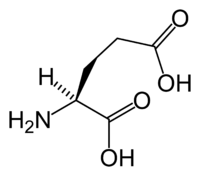
Photo from wikipedia
ABSTRACT N‐methyl‐d‐aspartate receptors (NMDARs) are profound regulators of glutamate neurotransmission and behavior. To coordinate components of the limbic system, the dorsal and ventral striatum integrate cognitive and emotional information towards… Click to show full abstract
ABSTRACT N‐methyl‐d‐aspartate receptors (NMDARs) are profound regulators of glutamate neurotransmission and behavior. To coordinate components of the limbic system, the dorsal and ventral striatum integrate cognitive and emotional information towards the execution of complex behaviors. Striatal outflow is conveyed by medium spiny neurons (MSNs), which can be dichotomized by expression of dopamine receptor subtype 1 (D1) or adenosine receptor subtype 2A (A2A). To examine how striatal NMDAR function modulates reward‐related behaviors, we generated D1‐ and A2A‐specific genetic deletions of the obligatory GluN1 subunit. Interestingly, we observed no differences in any GluN1−/− genotype in reward learning as assessed by acquisition or extinction of cocaine conditioned place preference (CPP). Control and A2A‐GluN−/− mice exhibited robust cocaine‐primed reinstatement, however this behavior was markedly absent in D1‐GluN−/− mice. Interestingly, dual D1‐/A2A‐GluN−/− mice displayed an intermediate reinstatement phenotype. Next, we examined models of exploration, anxiety, and despair, states often associated with relapse to addiction‐related behavior, to determine NMDAR contribution in D1 and A2A cell types to these behaviors. D1‐GluN1−/− mice displayed aberrant exploratory locomotion in a novel environment, but the phenotype was absent in dual D1/A2A‐GluN1−/− mice. In contrast A2A‐GluN1−/− mice displayed a despair‐resistant phenotype, and this phenotype persisted in dual D1/A2A‐GluN−/− mice. These data support the hypothesis that cell type‐specific NMDAR signaling regulates separable behavioral outcomes related to locomotion, despair, and relapse. This article is part of the Special Issue entitled ‘Ionotropic glutamate receptors’. HIGHLIGHTSAcquisition of cocaine CPP remains intact in D1‐GluN1−/− and A2A‐GluN1−/− mice.D1‐GluN1−/− mice do not reinstate CPP following cocaine challenge.D1‐GluN1−/− mice display abnormal exploration; rescued by A2A‐GluN1−/− co‐deletion.A2A‐GluN1−/− mice and D1/A2A‐GluN1−/− mice resist behavioral despair.
Journal Title: Neuropharmacology
Year Published: 2017
Link to full text (if available)
Share on Social Media: Sign Up to like & get
recommendations!